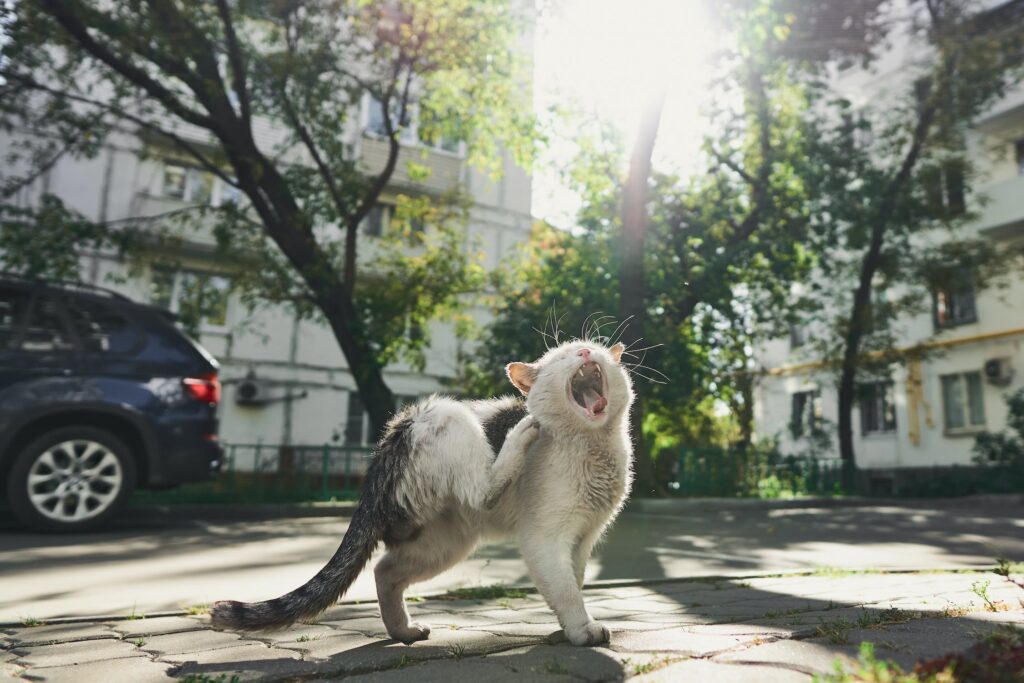
Fleas: the pesky little critters that can turn your friendly feline into a scratching mess. If you suspect your beloved cat has fallen victim to these blood-sucking pests, fear not! We’ll guide you through the telltale signs indicating flea infestation in your furry friend.
From constant scratching to tiny dark specks on their fur, we’ll uncover the clues and teach you how to tell if your cat has fleas.
So, let’s jump right into the world of cat fleas and learn how to protect your feline companion from these bothersome insects.
Common Signs of Flea Infestation in Cats
It’s important to note that while these signs can point toward a flea infestation, they may also indicate other skin conditions or allergies. If you suspect your cat has fleas, it’s always best to consult a veterinarian for a proper diagnosis.
Here are the most common signs to look out for:
1. Excessive Scratching and Biting: Fleas are incredibly itchy, and cats naturally respond by scratching and biting at the affected areas. If you notice your cat constantly grooming, licking, or scratching themselves, particularly around their neck, back, tail, or belly, it could be a sign of fleas.
2. Presence of Flea Dirt: Flea dirt, also known as flea feces, is a telltale of a flea infestation. Flea dirt resembles tiny black or dark brown specks resembling ground pepper or dirt. You may find these specks on your cat’s fur, especially in areas where fleas commonly hide, such as the base of the tail or the abdomen.
3. Visible Fleas or Flea Bites: In severe infestations, you may spot the fleas themselves scurrying through your cat’s fur. They are agile and can move quickly, so keep a close eye. Additionally, you might notice red, raised bumps or small scabs on your cat’s skin, which are signs of flea bites.
4. Hair Loss or Skin Irritation: Constant scratching and biting can lead to hair loss and irritated skin. If your cat has developed patches of thinning hair or areas of redness and inflammation, it could be due to flea infestation.
5. Restlessness and Behavioral Changes: Fleas can cause significant discomfort, making your cat restless and agitated. You may notice behavioral changes such as increased restlessness, excessive grooming, or even aggression.
6. Pale Gums: In severe flea infestations, cats can suffer from anemia due to blood loss. One indicator of anemia is pale gums. Check your cat’s gums by gently lifting their lip to see if they appear pale instead of their typical pink.
Remember, these signs are not exclusive to fleas, and other conditions can cause similar symptoms. If you suspect fleas, consult your veterinarian for a proper diagnosis.
How to Tell if Your Cat Has Fleas
While the signs mentioned above strongly indicate a flea infestation, it’s essential to confirm the presence of fleas to ensure appropriate treatment. To do so, you can perform a “Flea Comb Test.” Here’s how:

1. Choose a fine-toothed flea comb to trap fleas and their eggs.
2. Gently comb through your cat’s fur, closely examining the neck, back, belly, and tail regions.
3. After each stroke, inspect the comb for fleas, flea dirt, or tiny black specks.
4. Place any debris or specks onto a white paper towel or tissue and dampen it slightly.
5. If the specks turn reddish-brown upon dampening, it confirms the presence of flea dirt, as it contains digested blood.
Still wondering how to tell if your cat has fleas? If you find fleas or flea dirt during the combing process or notice the reddish-brown specks on the dampened tissue, it clearly indicates a flea infestation. Now it’s time to take swift action to protect your cat and eliminate the fleas from your home.
Treating Fleas in Cats
Once you have confirmed a flea infestation in your cat, it’s crucial to take immediate steps to eliminate the fleas and relieve your furry companion. Here are effective treatment options to consider:
1. Topical Flea Treatments: Topical flea treatments, such as spot-on medications, are applied directly to your cat’s skin. These treatments typically contain insecticides that kill adult fleas and prevent their reproduction. Follow the instructions provided by the product manufacturer and consult your veterinarian for recommendations.
2. Oral Flea Medications: Oral flea medications are pills or chewable ingested by your cat. These medications work systemically, meaning they circulate through your cat’s bloodstream and kill fleas when they bite. Speak to your veterinarian to determine the most suitable oral flea medication for your cat.
3. Flea Shampoos and Dips: Flea shampoos and dips can provide immediate relief by killing fleas on contact. These products are typically used during a bath and can help reduce the number of adult fleas on your cat. However, they may not provide long-term protection against re-infestation.
4. Flea Collars: Flea collars are worn around your cat’s neck and emit chemicals that repel and kill fleas. Look for collars designed for cats and carefully follow the instructions for proper usage and duration.
Flea treatments formulated specifically for cats should never be used on dogs or other animals. Always consult your veterinarian before administering any flea treatment to ensure it’s safe and suitable for your cat’s needs.
Preventing Flea Infestations
No more wondering how to tell if your cat has fleas! Prevention is vital when it comes to fleas. Protect your cat and your home by implementing preventive measures:
1. Regular Flea Control: Establish a routine using veterinarian-approved products. Consistent use of flea preventives can help keep fleas at bay and protect your cat from infestations.
2. Environmental Management: Clean your living space and reduce potential flea habitats. Vacuum frequently, paying attention to areas where your cat spends time. Wash bedding, blankets, and other fabric items in hot water to kill any potential fleas or eggs.
3. Yard Maintenance: Fleas can thrive outdoors, so maintain your yard. Keep grass and shrubs trimmed, remove debris where fleas can hide, and consider treating your outdoor areas with pet-safe flea control products.
4. Regular Grooming: grooming your cat with a flea comb can help catch fleas early on. The comb’s fine teeth can capture adult fleas and flea dirt, allowing swift action.
Innovative Can Help You Stay Flea-free!
Flea infestations can be a bothersome experience for both you and your cat. By recognizing the signs early on and taking prompt action, you can protect your furry friend from the discomfort caused by fleas.
At Innovative Pest Solutions, we specialize in helping Raleigh, North Carolina, residents eliminate fleas and ensure the safety of their cats. Our experienced technicians conduct thorough inspections to assess the extent of the infestation and develop customized treatment plans.
With our expertise in integrated pest management, ongoing monitoring, and excellent customer service, we provide reliable solutions to keep your Raleigh home flea-free and protect your furry companion. Contact us today for a consultation, and let us take care of your Raleigh, North Carolina, flea problem.





